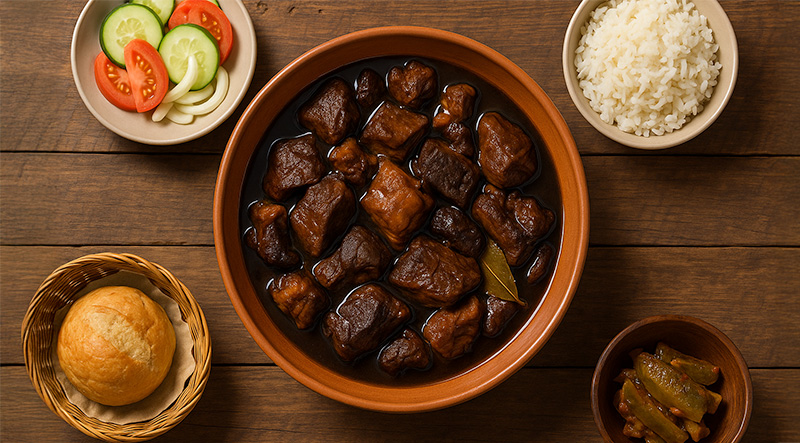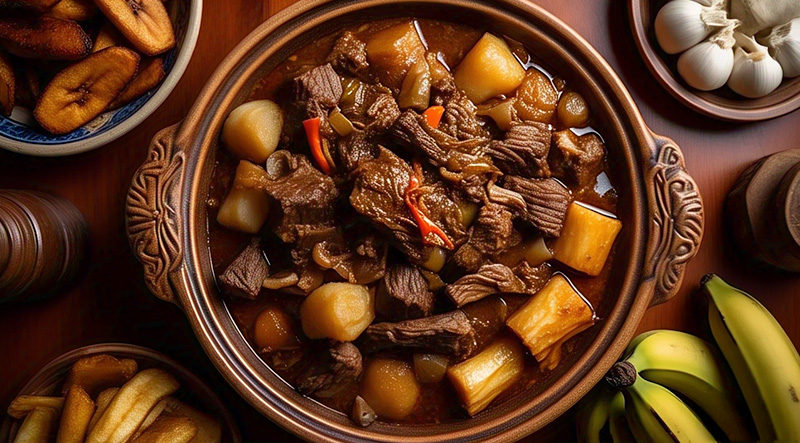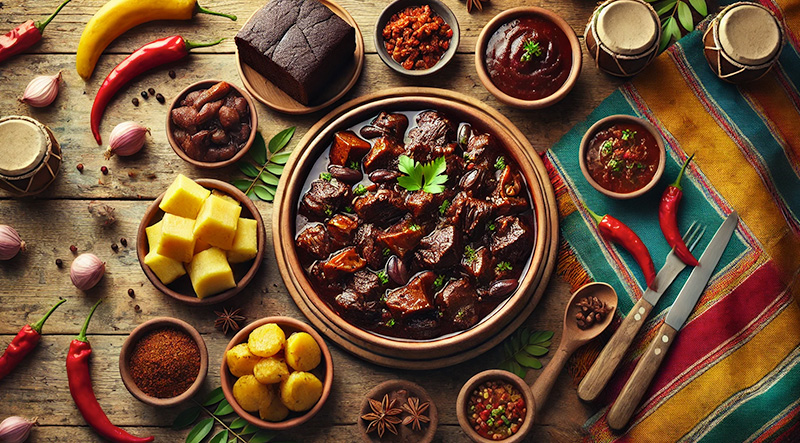Guyanese cuisine's flavorful core is pepperpot, which is rich, robust, and deeply rooted in tradition. Tender cuts of meat, typically beef or pork, are simmered in a rich, dark sauce made from cassareep, a thick, slightly bitter syrup made from cassava, and flavored with hot peppers, cloves, cinnamon, and other aromatic spices. Pepperpot, which is typically made for Christmas morning but is enjoyed all year round, has a unique flavor that is sweet, spicy, and smoky. This slow-cooked stew, which is served with rice or freshly made bread, is more than just a meal; it's a celebration of Guyana's strong sense of community and cultural heritage. Read More...
The History of Pepperpot – Guyana’s Iconic National Dish:
Pepperpot, a dark, spicy, and richly flavored meat stew, stands as the national dish of Guyana, symbolizing the country’s diverse cultural heritage and culinary ingenuity. Known for its deep brown color and complex taste, Pepperpot is traditionally prepared during Christmas and special celebrations, though its roots and significance go far deeper into the country’s Amerindian past.
Amerindian Origins and Cassareep:
The story of Pepperpot begins with Guyana’s indigenous peoples, particularly the Amerindian tribes such as the Arawak and Carib. These communities developed a unique cooking technique using cassareep, a thick, molasses-like syrup made from the juice of bitter cassava root. Cassareep served a dual purpose—it added flavor and, most importantly, acted as a natural preservative in the hot tropical climate, allowing meat stews to last for days without refrigeration.
This preservation method made Pepperpot not just a dish, but a practical solution for food storage and survival. The original versions of the dish were often simple, using wild meats and local herbs, cooked slowly in large clay pots over open fires.
African and European Influences:
As Guyana’s population diversified through colonialism and slavery, the dish evolved. Enslaved Africans brought bold spice traditions and cooking techniques, while European colonizers introduced new meats, such as beef and pork, and additional spices like clove, cinnamon, and nutmeg. These influences helped shape the Pepperpot known today—a dish that marries indigenous cooking methods with African spice blends and colonial-era adaptations.
The stew gradually became a symbol of unity and culinary fusion, representing the blend of cultures that defines Guyanese identity. Over time, Pepperpot transitioned from an everyday survival food to a special occasion delicacy, often cooked for Christmas Day breakfast, where it simmers overnight and is eaten early with thick slices of homemade bread.
The Taste of Tradition:
Today, Pepperpot is considered the culinary crown jewel of Guyana. It’s known for its deep, earthy flavor and velvety texture, thanks to the slow simmering of meat in cassareep and spices for several hours. Though variations exist—some families include goat, mutton, or even chicken—the essence of the dish remains unchanged. Recipes are often handed down through generations, each household adding its own twist while honoring the original preparation methods.
What makes Pepperpot truly unique is that it encapsulates history, culture, and celebration in a single dish. It’s a link to Guyana’s indigenous past, a reflection of its colonial struggles, and a cherished part of its modern cultural identity.
A Dish That Tells a Story:
More than just a stew, Pepperpot is Guyana on a plate—a dish that tells stories of ancestors, endurance, and shared traditions. Whether served during the holidays or on a family Sunday morning, every bowl is rich not only in flavor but in history and heart.
Season the Meat:

Brown the Meat (Optional):

Start the Stew:

Simmer Slowly:
Adjust Seasoning:

Serve:
The total preparation and cooking time for Pepperpot is approximately 3.5 to 4 hours. Initial prep, including cutting and seasoning the meat and gathering ingredients, takes about 30 to 45 minutes. If you choose to marinate the meat overnight for deeper flavor, it adds additional resting time but no active prep. The cooking process takes 2.5 to 3 hours on low heat, allowing the meat to become tender and the cassareep sauce to develop its rich, signature flavor. While the dish can be enjoyed the same day, it’s traditionally made a day ahead to allow the flavors to intensify when reheated.
A single serving of Pepperpot, based on the recipe provided and assuming six servings, contains approximately 550 to 700 calories. The calorie count comes primarily from the beef and pork, which provide around 400–500 calories depending on the cut and fat content. Cassareep adds about 100–120 calories per serving, while the small amount of oil and sugar contribute an additional 30–50 calories. Spices and herbs add minimal calories but significantly boost flavor. If served with a slice of homemade bread or a portion of white rice, the total can increase by another 100–150 calories, making Pepperpot a hearty and satisfying dish.







